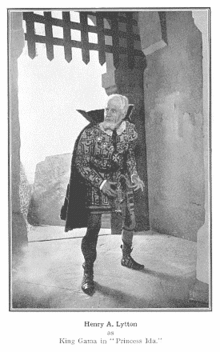Percy Anderson
Percy Anderson (1851 – 30 October 1928) was an English stage designer and painter, best known for his work for the D'Oyly Carte Opera Company, Sir Herbert Beerbohm Tree's company at His Majesty’s Theatre and Edwardian musical comedies.

Life and career
Anderson's first significant production was the comic opera Lady of the Locket, composed by William Fullerton Jr. with a libretto by Henry Hamilton.[1] Beginning with The Yeomen of the Guard (1888), Anderson designed the costumes for all the original productions of the Savoy Operas. He continued to design costumes for D'Oyly Carte revivals in the early twentieth century, including for Trial by Jury, H.M.S. Pinafore, The Pirates of Penzance, Patience, Iolanthe, Princess Ida, Ruddigore, The Yeomen of the Guard, and The Gondoliers. For Herbert Beerbohm Tree at His Majesty's Theatre, Anderson designed Twelfth Night, The Merry Wives of Windsor, Richard II, King John, A Midsummer Night’s Dream, The Tempest, and two plays by Stephen Phillips, Herod and Ulysses.[2] He designed the costumes for Henry James’s ill-fated theatrical effort, Guy Domville; The Times was not impressed by either the play or the costumes.[3]
Among Anderson's other successes were Trelawny of the 'Wells' (1898), Merrie England (1902), Véronique (1904), the hit British premiere of The Merry Widow in 1907, Fallen Fairies (1909), Kismet (1911) and Chu Chin Chow (1916). He designed the costumes for various productions of Edwardian musical comedies for George Edwardes, such as the hit musical San Toy in 1899 and The Duchess of Dantzic in 1903.[4] The Royal Opera House commissioned Anderson to design costumes in 1900.[5] Anderson's designs were also used in a number of Broadway productions.[6]
Anderson had private means, and for a time roomed with Morton Fullerton. He was part of a circle of rich, artistic homosexual men, who included Lord Ronald Gower, the courtier Alec Yorke and Hamilton Aïdé.[7] In the 1910s, Anderson was closely associated with the young novelist Hugh Walpole[8]
The Times, in its obituary notice, said of Anderson that he escaped from the pedantry of his predecessors and paved the way in a most interesting manner for Bakst, Claud Lovat Fraser and Gordon Craig.[2] As a painter, Anderson achieved a modest success, and his portraits hang in the collections of the National Portrait Gallery, the Louvre, and the British Museum.[9] He illustrated the 1907 book, Costume: Fanciful, Historical and Theatrical.[10]
Anderson died in King's College Hospital, London, in 1928, aged 76 or 77.[2]
Notes

- Coffin, pp. 25–27 and 34–39
- The Times, 31 October 1928, p. 16
- The Times, 7 January 1895, p. 13
- Lily Elsie, Lily-Elsie.com
- "Biography of Milka Ternina describing Anderson costumes designed for her" (PDF). Archived from the original on December 3, 2007. Retrieved 2009-01-10.CS1 maint: BOT: original-url status unknown (link)
- Percy Anderson at the IBDB database
- Mainwaring, pp. 43 and 78
- Hart-Davis, p. 79
- Portrait of Winifred Dickinson by Anderson Archived 2013-04-20 at Archive.today
- Costume: Fanciful, Historical and Theatrical, compiled by Mrs. Eliza Davis Aria. (1907) New York: The Macmillan Company.
References
- Coffin, C. Hayden. Hayden Coffin's Book: Packed with Acts and Facts, London: Alston Rivers (1930)
- Hart-Davis, Rupert. Hugh Walpole (1997) Sutton Publishing, Stroud (orig Macmillan, London, 1952); ISBN 0-7509-1491-2
- Mainwaring, Marion. Mysteries of Paris: the Quest for Morton Fullerton, University of New England Press, 2001
- Rollins, Cyril and R. John Witts. The D'Oyly Carte Opera Company in Gilbert and Sullivan Operas (1961) London: Michael Joseph Ltd.
External links
- Drawings of some Anderson designs at the Wayback Machine (archived September 8, 2007)
- Anderson costume for Lysander at the Wayback Machine (archived February 11, 2008) in A Midsummer Night's Dream at Her Majesty's Theatre, 10 January 1900
- 1893 designs for Utopia, Limited
- 1919 designs for The Yeomen of the Guard
- Anderson's designs at the Harry Ransom Center collection